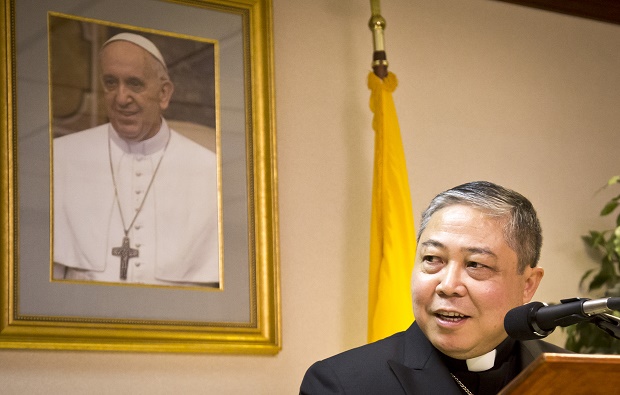
Archbishop Bernardito Auza, the Vatican’s apostolic nuncio and UN ambassador, speaks during a press conference, Wednesday, Sept. 9, 2015, in New York. Archbishop Auza said that in addition to addressing the 193-member General Assembly on Sept. 25, the pope will speak to UN staff and hold four private meetings including one with Russian President Vladimir Putin whose country chairs the UN Security Council this month. AP
UNITED NATIONS — Pope Francis is expected to focus on the need for peace in a conflict-torn world facing the biggest refugee crisis since World War II when he addresses the United Nations later this month, the Holy See said Wednesday.
Archbishop Bernardito Auza, the Vatican’s apostolic nuncio and UN ambassador, said the pope’s address, in his native Spanish, to the 193-member General Assembly on Sept. 25 will likely stress poverty and bad government as drivers of conflict and migration.
He said the plight of tens of thousands of migrants seeking safety and a new life in Europe will be touched on in the pope’s UN speech because it’s an international issue and “a universal problem.”
The archbishop said Francis’ 2 1/2-hour visit to the United Nations will be the fifth by a pope and the shortest because of time constraints.
Auza also said the pope will meet Russian President Vladimir Putin, whose country holds the rotating presidency of the UN Security Council this month. But Alexey Zaytsev, spokesman for Russia’s UN Mission told AP: “From what we know President Putin is not here on Sept. 25.” Putin has met the pope at least twice previously.
Auza said the pope is expected to express appreciation in his General Assembly speech for the UN role in trying to minimize conflict and alleviate suffering — but he said the world body has also seen “lots of failures.”
“There is no greater failure of the UN than to be incapable, unable to prevent what is going on in the Middle East now and North Africa,” the archbishop said.
Immediately after he leaves UN headquarters, Francis will head to the site where the World Trade Center stood before the Sept. 11, 2001 attacks, a visit Auza said the pope insisted upon.
During his UN visit, Francis will have a one-on-one meeting with Secretary-General Ban Ki-moon and then a larger meeting with U.N. and Vatican officials, Auza said.
He will then address UN staff members and hold private meetings with the outgoing and incoming assembly presidents, Auza said.
Auza said the pope will be staying at his residence on New York’s fashionable upper East Side which was given to the Holy See in the 1970s as the residence for its UN representative by the family of New York mayor Hugh Grant who built it and died there in 1910.